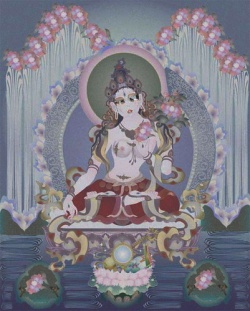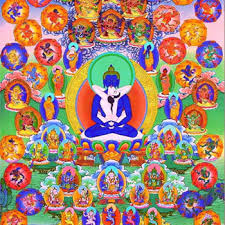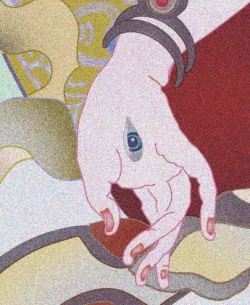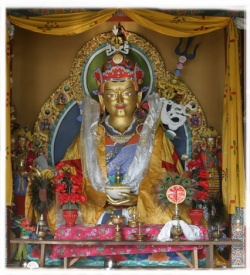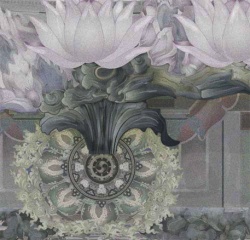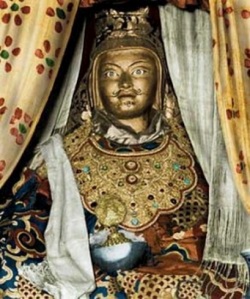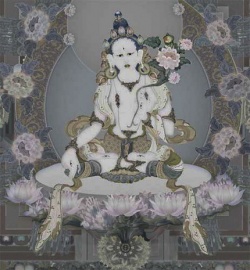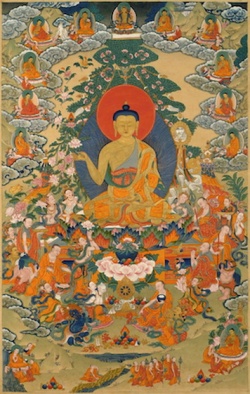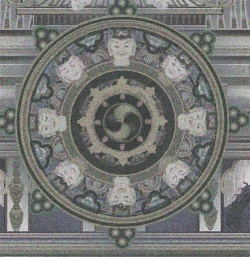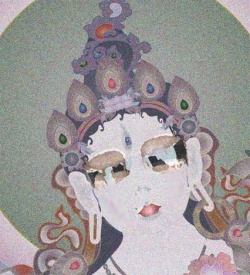Contributions of the Pangtangma Catalogue to the History of the Royal Lineage
The chronology of events during the reign of Tri Songdetsen poses some very important problems concerning the history of the Tibetan Empire. Chief among these are the dates for the foundation of Samyé Monastery, and the dates for the Samyé Inscription and the accompanying edicts preserved in the Khepé Gatön, as these announce the adoption of Buddhism as the official religion of Tibet. These are particularly difficult to determine because the two major sources for the history of the Tibetan Empire, the Old Tibetan Annals and the Old Tibetan Chronicle, both end during the first part of Tri Songdetsen’s reign. Concerning the royal succession itself, the dates of Tri Songdetsen’s death are also unclear, as are the regnal dates of his short-lived successor, Muné Tsen/Muné Tsenpo. Many post-dynastic histories preserve a tradition according to which Tri Songdetsen abdicated in favor of his son, Muné Tsenpo.25 This is most often reckoned to have occurred in 797. Tri Songdetsen’s death is generally recorded shortly thereafter, and Muné Tsenpo is usually said to have reigned for less than two years.26
The post-dynastic histories are hopelessly confused regarding the names of Tri Songdetsen’s sons. In a long article, Haarh clarifies the tangle of names in post-dynastic histories.27 As he points out, some of the most influential Tibetan histories, including the Bazhé, Gyelrap Selwé Melong, and the Khepé Gatön, contribute to the confusion surrounding this issue by using the name Mutik Tsenpo to refer “more or less arbitrarily” to either of Tri Songdetsen’s last two sons.28 Subsequent scholars, both within and outside of Tibet, have repeated these errors. Relying mostly on a useful passage from Urgyen Lingpa’s Gyelpo Katang Yik, Haarh reveals that Mutik Tsenpo is none other than Tri Desongtsen, alias Senalek Jingyön.29 This is, of course, the father of Tri Tsukdetsen, alias Relpachen. Haarh concludes that Tri Songdetsen had four sons, the first being Mutri Tsenpo, who died young. Despite the fact that [page 8] this name is also conflated with those of the three later sons, Haarh argues that Mutri Tsenpo is to be identified with the son whose birth is registered in the Old Tibetan Annals’ entry for the mouse year 760.30 The remaining three sons, according to Haarh, are Muné Tsenpo, Murug Tsenpo, and Mutik Tsenpo, alias Tri Desongtsen, whose births he dates sequentially to the tiger, hare, and dragon years 774, 775, and 776.31 Haarh worked almost exclusively from post-dynastic histories, so these dates cannot be accepted with certainty. Employing Old Tibetan sources alongside the Pangtangma Catalogue, however, I will uphold Haarh’s earlier conclusions regarding the names of Tri Songdetsen’s sons.
The matter of the identities of Tri Songdetsen’s sons is easily resolved in comparison to the problem of the events surrounding their royal succession. In his article devoted to the succession to Tri Songdetsen, Haarh attempted to harmonize post-dynastic Tibetan sources with a passage in the Tang Annals and other Chinese sources that recorded the death of a Tibetan emperor in 804. Haarh concludes that this reflected a struggle for succession between Murug Tsenpo and his younger brother Tridé Songtsen, and that the former, while not a legitimate emperor, was recognized by the Chinese as such.32 Consequently, Haarh argues, the Chinese sources that record the death of an emperor (tsenpo) in 804 in fact refer to Murug Tsenpo.33 Considering the evidence of the Pangtangma Catalogue, and that of Old Tibetan sources, I will come to similar conclusions here.
The Pangtangma Catalogue demonstrates, in fact, that the Chinese were not alone in recognizing Murug Tsenpo/Muruktsen as emperor, but that he was recognized as such in Tibet as well. A fascinating entry in the section under the misleading heading “commentaries on sūtras and śāstras by Tri Songdetsen” records a commentary to the noble Saṃdhinirmocanasūtra, attributed to “Emperor Muruktsen.”34 While Muruktsen is mentioned in a pillar inscription at Zhé Lhakhang as the elder brother of Tri Desongtsen, the Pangtangma [page 9] Catalogue is the only known Tibetan source that refers to him explicitly as an emperor. Let us now consider this new evidence as it relates to what is known of the succession from Old Tibetan sources, turning first to inscriptional evidence.
The Kongpo Inscription reveals that Tri Songdetsen ruled jointly with Desong, his chosen heir, who, when he took the throne, was known as Tri Desongtsen. This is evident from the fact that the inscription opens, “A decree granted to Kong Karpo during the reign of the divine emperor Tri Songdetsen and Desong, father and son” (lines 1-3).35
The west inscription at Zhé Lhakhang, which records grants made to Nyang Tingngedzin Zangpo and his clansmen in recognition for their service to Tri Desongtsen, reveals that before Desong was enthroned as Tri Desongtsen there was friction between two parties, the one being Tri Songdetsen, and the other being Tri Desongtsen’s elder brother, Muruktsen, and that this was followed by a period of upheaval. Lines nine to twelve read:
ḷater, after the harmful struggle between my father and elder brother, at the time when ī had not yet taken over the polity, there were also some who fomented disturbance and civil strife... (lines 9-12).36
It is probably safe to assume that the dispute between Tri Songdetsen and his son concerned succession. The identity of this quarrelsome royal scion is made clear in lines 48-50 of the inscription, which lists some of those who swore to uphold the grants and privileges it records:
ṃy elder brother ṃuruktsenṃu rug brtsan, the royal ladies, minor kings, political ministers on downwards, and indeed all greater and lesser ministers swore an oath. ṭhe decree is given in perpetuity.37
This passage further demonstrates that Tri Desongtsen ruled alone at the time of the inscription, and subordinated his elder brother Muruktsen, who, along with queens, minor kings (gyeltren), and ministers, was bound by oath to uphold Tri Desongtsen’s edict.
By the time of the later, east face inscription at Zhé Lhakhang, dated to “the later dragon year,”38 there is no mention of Muruktsen. By naming a later dragon year, the dating formula of this later inscription does indicate, however, that Tri Desongtsen claimed the previous dragon year, 800, as part of his reign.39 This does not necessarily indicate, however, that it was the first year of his reign.
The absence of Muruktsen in the later inscription at Zhé Lhakhang might indicate that he was safely out of the picture by 812. Another inscription dating to the reign of Tri Desongtsen, however, predates this inscription, and makes no mention of Muruktsen. This is the Denma Drak Inscription, which dates to the monkey year 804.40 This indicates that by the year 804, for reasons that are as yet unclear, Tri Desongtsen had no need to refer to or bind under oath his troublesome elder brother Muruktsen.
To summarize the inscriptional evidence, the Kongpo Inscription and the inscriptions at Zhé Lhakhang indicate that Tri Songdetsen ruled jointly with Prince Desong/Tri Desongtsen, and came into serious conflict with Desong’s elder brother, Muruktsen. Tri Songdetsen then died, and sometime thereafter Desong was enthroned as Tri Desongtsen.
This picture is complicated somewhat by the presence in Old Tibetan sources of another one of Tri Desongtsen’s brothers, Muné Tsen. The Royal Genealogy (PT 1286) states that Tri Songdetsen and Lady Magyel Dongkar of the Tsepong clan bore the sons Muné Tsen and Desongtsen, and that Mu[né] Tsen’s line was cut off (dungché).41 This official or quasi-official [page 11] royal genealogy therefore indicates that Muné Tsen ruled as emperor between Tri Songdetsen and Tri Desongtsen. It says nothing, however, of Muruktsen. What are we to make, then, of Muruktsen’s absence in this Royal Genealogy when the Pangtangma Catalogue explicitly designates him as an emperor? First of all, the Royal Genealogy, as an official or semi-official document composed near to or after the collapse of the Tibetan Empire in the mid-ninth century, was an idealized lineage. This is not to say that the document is inaccurate or represents a whitewash, but only to point out that its imperative was to simplify the royal succession and emphasize the continuity of the royal line from its first mythical ancestor until the last emperor of royal blood. This genealogy, for example, does not mention Lhabelpo, elder brother of Tridé Tsuktsen (704-c. 754), who seized the throne for a short while after his father’s death in 704, and was deposed in 705.42 While the Pangtangma Catalogue was also an official document, sponsored by the Tibetan emperor, its compilers obviously felt no need to excise from the record a composition by Emperor Muruktsen, and in doing so they have handed down valuable information regarding the royal succession.
[page 12]
Taking into account the inscriptional evidence, the Royal Genealogy (PT 1286), and the evidence of the Pangtangma Catalogue, the events surrounding the royal succession of Tri Songdetsen’s sons seems to be as follows. Tri Songdetsen abdicated in favor of his son, Muné Tsen.43 Muné Tsen then ruled for a short time before he died. Tri Songdetsen, like his ancestor, Songtsen Gampo (d. 649), then retook the throne following the death of his son, and groomed his successor, Tri Desongtsen, with whom he ruled jointly. This upset Tri Songdetsen’s elder son, Muruktsen, and serious conflict ensued. Tri Songdetsen died, and the two sons, Muruktsen and Tri Desongtsen, disputed the succession. Muruktsen briefly gained the upper hand and was recognized as emperor for a short period of time before Tri Desongtsen deposed him and took the throne. Muruktsen was at first subordinate to his younger brother, but subsequently disappeared from the picture. Further, it is quite possible, as argued by Haarh, that China recognized Muruktsen as emperor, and that it was his death that Chinese sources refer to in their accounts of the year 804.44 It therefore seems likely that Muruktsen indeed ruled as Tibetan emperor for a short time before he was deposed by his younger brother, Tri Desongtsen.
While the order of events proposed above is quite likely, the chronology is less certain. There are two main problems with establishing a chronology, the first being the date of Tri Songdetsen’s abdication and the rule of Muné Tsen, as these dates are not found in Old Tibetan documents, and are therefore necessarily based on post-dynastic sources. The second problem concerns the dates for Emperor Muruktsen’s reign. While in the later, east face inscription at Zhé Lhakhang, dated to “the later benevolent dragon year” 812, Tri Desongtsen claims 800 as a year of his reign, he may well be discounting the reign of his usurper, and counting this as his own. That is to say, 800 is not necessarily the terminus a quo for Muruktsen’s reign: he could have ruled at any time between Tri Songdetsen’s death and 804, the likely year of his own death, but, as in the case of the official or semi-official Royal Genealogy (PT 1286), this would have been expunged from the official record.
Most post-dynastic sources agree that Tri Songdetsen abdicated in favor of Muné Tsenpo in 797. Of course, many of these sources also state that Tri Songdetsen died shortly thereafter, but the Old Tibetan sources demonstrate that these claims are mistaken. The early Sakya histories, the Bökyi Gyelrap of Drakpa Gyeltsen (1147-1216) and the eponymous work of Pakpa (1238-1280), both state that Tri Songdetsen died at age 56 in an ox year, and that Muné Tsenpo succeeded him for either one year and nine months or for two years.45 Given that the Old Tibetan Annals records Tri Songdetsen’s birth in 742, this would place his death in approximately 797. Other Tibetan histories, such [page 13] as the Gyabökyi Chöjung Gyepa of Khepa Deu46 and the Khepé Gatön, state that Tri Songdetsen died at age fifty-nine, which corresponds to 800.47 The newly published Bazhé states that Tri Songdetsen died in a horse year, which corresponds to 802.48
Regarding the death of Muruktsen, later sources state that Muruktsen was killed by a member of the Nanam clan in retribution for his murder of Nanam Uring, son of Prime Minister Sna nam Rgyal mtshan lha snang.49 This is also stated in the Sangwa Chakgyachen, one of the five texts comprising the Chennga, which were standard historical texts that Karmay dates to the late ninth or early tenth centuries.50 There, however, Muruktsen is called Mutik Tsenpo, underlining the confusion whereby the latter name is attributed sometimes to Muruktsen, other times to Tri Desongtsen.51
According to another tradition, found in Neu Pendita’s Chöjung Metok Trengwa, Muruktsen became a monk after his murder of Nanam Uring. Further, this text also contains a tradition according to which Muruktsen – referred to here as Mutik Tsenpo – built Trana Temple (trané lhakhang). A gloss states that the temple is known as Nyamtrü Namdakgi Tsuklakkhang, and that it was built by the divine emperor to expiate his sins from having killed Uring. The text goes on to state that he also built Kongyül Kyangbutsel Temple (kongyül kyangbutselgyi lhakhang) and became a monk.52 [page 14]
Despite the ample evidence concerning the death of Muruktsen, including a royal tomb, Bhutanese tradition claims him as a protagonist in their hidden land (beyül) literature. According to this tradition, he is identified with Khyikha Ratö (literally, “Dog mouth Goat skull”), the offspring of Tsepong Zamargyel’s bestial liaison with a dog and a goat. Aris sees in Khyikha Ratö an independent figure, whose lore grew to include Muruktsen and the much-maligned Queen Tsepong Zamargyel.53 This may in fact have a historical basis, as the Nyangrel Chöjung states that Muruktsen – referred to here again as Mutik Tsenpo – returned from exile in Mön to take the throne after Muné Tsenpo’s death. Upon arrival, however, he was killed by members of the Nanam clan.54 Mön, of course, is a vague toponym-cum-ethnonym that denotes the south, and often includes Bhutan and Sikkim.
Given this unruly tangle of dates to choose from for Tri Songdetsen’s death, it seems better to return to the Old Tibetan sources for guidance. If we cautiously accept Tri Desongtsen’s claim in the east face inscription at Zhé Lhakang that he ruled Tibet in the dragon year 800 (either jointly with his father or alone), we might propose the following tentative chronology. Following post-dynastic sources, Tri Songdetsen abdicated c. 797 in favor of his son, Muné Tsen. Muné Tsen then ruled for two years or less, c. 797-c. 798, before he died. Tri Songdetsen then retook the throne and ruled jointly with his chosen successor, Desong/Tri Desongtsen, c. 798-c. 800. This upset Tri Songdetsen’s elder son, Muruktsen, and serious conflict ensued. Perhaps as a result of this conflict, Tri Songdetsen died, probably in 800 (i.e., at age fifty-nine as claimed in Khepa Deu’s Gyabökyi Chöjung Gyepa). His two sons, Muruktsen and Tri Desongtsen, then disputed the succession in a contest that threatened to cause civil unrest. Muruktsen’s brief ascendancy as emperor likely dates to c. 800-c. 802, shortly after Tri Songdetsen’s death. Tri Desongtsen, with the help of powerful allies such as Nyang Tingngedzin Zangpo, then gained the upper hand and retook the throne in c. 802, and Muruktsen died not long after, in c. 804.
While the order of events is established almost exclusively from the evidence of Old Tibetan sources, the chronology is less certain, and is meant only as a working hypothesis to help guide this problem to its final resolution. Besides resolving to a certain extent the succession at the turn of the ninth century, this proposed chronology also suggests dates for the Kongpo Inscription and the west inscription at Zhé Lhakhang. The former was erected when Tri Songdetsen ruled jointly with Desong, and therefore dates to c. 798-c. 800. The latter [page 15] refers to a period in Tri Desongtsen’s reign before the death of Muruktsen, and can therefore be placed between c. 800 and 804.
[25] Per K. Sørensen, Tibetan Buddhist Historiography: The Mirror Illuminating the Royal Genealogies (Weisbaden: Harrassowitz Verlag, 1994), 403 n. 1377.
[26] Sørensen, Tibetan Buddhist Historiography, 406 n. 1401.
[27] Erik Haarh, “The Identity of Tsu-chi-chen, the Tibetan ‘King’ Who Died in 804 AD,” Acta Orientalia 25 (1960): 121-70.
[28] Haarh, “The Identity of Tsu-chi-chen,” 149.
[29] Haarh, “The Identity of Tsu-chi-chen,” 147-48.
[30] Haarh, “The Identity of Tsu-chi-chen,” 149, 152. See also Jacques Bacot, Frederick W. Thomas, and Charles Touissant, Documents de Touen-Houang Relatifs a l’Histoire du Tibet (Paris: Libraire Orientaliste Paul Geuthner, 1940-1946), 58, 65.
[31] Haarh, “The Identity of Tsu-chi-chen,” 153.
[32] Haarh, “The Identity of Tsu-chi-chen,” 164-69.
[33] Haarh further argues that the struggle for succession was an expression of conflict between Bönpo and Buddhist factions, but, due to the fact that this point rests on rather simplistic assumptions concerning “pre-Buddhist Bön religion” and “royal religion,” I cannot support this conclusion. Indeed, while there is certainly continuity in terms of the practices of those ritual specialists known as bön (po) and shen during the imperial period and some of the rites of the institutionalized Bön religion, particularly those of the first four of the nine vehicles, it has never been established with any certainty that “Bön” constituted a religion per se during the imperial period (though this depends in large part on what one means by “religion”). The role of bön and shen in Old Tibetan ritual texts is taken up in detail in Brandon Dotson, “Complementarity and Opposition in Early Tibetan Ritual,” Journal of the American Oriental Society (forthcoming).
[34] ’phags pa dgongs pa nges par ’grel pa’i mdo bshad pa btsan po mu rug btsan gyis mdzad pa/ (Rta rdo, Dkar chag ’phang thang ma, 55). This was also noted by Halkias (“Tibetan Buddhism Registered,” 56-57), who further recognized its possible relation to the claim in Chinese sources regarding the death of a Tibetan emperor in 804.
[35] lha btsan po khr-i srong lde brtsan dang / lde srong yab sras ky-i ring la’// // rkong kar po la gts-igs gnang ba’//. Li and Coblin, A Study of the Old Tibetan Inscriptions, 198, 205, 208.
[36] // phyis yab dang gcen thugs nongs brtud par byung ba’i rjes // nga chab sr-id ma bzhes pa’i skabsu kha cig phan phun dang / gdon stson pa dag yod pa yang / (Li and Coblin, A Study of the Old Tibetan Inscriptions, 264, 276). My translation differs slightly from that of Li and Coblin. For comparison, see also Hugh E. Richardson, A Corpus of Early Tibetan Inscriptions (London: Royal Asiatic Society, 1985), 46-47. In both Li and Coblin’s translation and that of Richardson, “disagreement” is not strong enough for tuknong, which, while literally meaning “harming the mind,” can also indicate killing.
[37] // gcen mu rug brtsan dang / jo mo mched dang rgyal phran rnams dang / chab srid kyi blon po man chad / zhang lon che phra kun kyang mnas bsgags te / gts-igs g.yung drung du gnang ngo /; Li and Coblin, A Study of the Old Tibetan Inscriptions, 266-67, 279-80. My translation differs slightly from that of Li and Coblin. For comparison, see also Richardson, A Corpus of Early Tibetan Inscriptions, 50-53.
[38] ’brug gi lo phyi ma.
[39] In fact, the passage refers to the “benevolent later dragon year” (kadrin drukgi lo chima, lines 22-23; Li and Coblin, A Study of the Old Tibetan Inscriptions, 271, 292). Li and Coblin translate this as “with regard to my grace, in the later Dragon year,” but this is borne out neither by the grammar nor the punctuation. Richardson (A Corpus of Early Tibetan Inscriptions, 56-57) seems to have ignored the presence of kandrin entirely in his reading of this passage. Intriguingly, the use of kandrin here before a year in the reign of Tri Desongtsen mirrors the use of kyitak, which in the Lhasa Treaty Pillar precedes dates during Tri Tsukdetsen’s reign (East face inscription, lines 58, 62, and 65; Li and Coblin, A Study of the Old Tibetan Inscriptions, 51, 98-99). As has been noted before, “eternal happiness” (kyitak) was the name given to Tri Tsukdetsen’s reign, following similar Chinese practices (Li and Coblin, A Study of the Old Tibetan Inscriptions, 114). While this was thought to be the only instance of such a Tibetan regnal name, we should not discount the possibility that the reign of his predecessor, Tri Desongtsen, was referred to as the “reign of benevolence” (kandrin).
[40] spre’u gi lo’i dbyar/ btsan po khri lde srong brtsan gy-i ring la/ (Chab spel tshe brtan phun tshogs, Btsan po’i dus kyi brag brkos yig ris gcig gsar du mtshams sbyor zhus pa, in Bod kyi yig rnying zhib ’jug, ed. Kha sgang bkra shis tshe ring [Beijing: Mi rigs dpe skrun khang, 2003 (1988)]). See also Yoshiro Imaeda, “Re-examination of the ldan ma drag Inscription (II) in Eastern Tibet,” in Old Tibetan Studies Dedicated to the Memory of Professor Ronald E. Emmerick (1937-2001), ed. Cristina A. Scherrer-Schaub, PIATS 2003: Proceedings of the Tenth Seminar of the International Association for Tibetan Studies, Oxford 2003 (Leiden: Brill, forthcoming). See, however, the 1998 addendum to an older article in Hugh E. Richardson, “More Early Inscriptions from Tibet,” in High Peaks, Pure Earth: Collected Writings on Tibetan History and Culture, ed. Michael Aris (London: Serindia, 1998 [1988]), 278, where Richardson supports the later date of 816 for this inscription.
[41] khri srong lde brtsan dang / tshes pong za rma rgyal ldong skar du bshos pa’-i sras/ mu ne brtsan dang / lde srong brtsan/ mu brtsan gdung chad nas/ (PT 1286, lines 67-69). For the text, see Ariane Spanien and Yoshiro Imaeda, Choix de documents tibétains conservés à la Bibliothèque nationale: complété par quelques manuscrits de l’India Office et du British Museum, Tome 2 (Paris: Bibliothèque nationale, 1979), plate 556. For transliteration, see Yoshiro Imaeda and Tsuguhito Takeuchi, Choix de documents tibétains conservés à la Bibliothèque nationale: complété par quelques manuscrits de l’India Office et du British Museum: Corpus syllabique, Tome 3 (Paris: Bibliothèque nationale, 1990), 16. For Bacot and Toussaint’s transliteration and French translation, see Bacot et al, Documents de Touen-houang, 82, 89. See also Brandon Dotson, “A Note on Źaṅ: Maternal Relatives of the Tibetan Royal Line and Marriage into the Royal Family,” Journal Asiatique 292, nos. 1-2 (2004): 86-88.
[42] The entry in the Old Tibetan Annals for the snake year 705 states, “At Ponglakrang, they deposed from the throne the emperor’s elder brother, Lhabelpo” (pong lag rang du btsan po gcen lha bal pho rgyal sa nas phab; IOL Tib J 750, line 101). See Bacot et al, Documents de Touen-houang, 19, 40-41. Beckwith, who contends that the above passage should be read as indicating the deposal of Lha from Belpo, finds it likely that he was the son or relative of Princess Gatün (meaning “princess” in Turkish), whose funeral is recorded in the winter of the snake year 708 (Christopher I. Beckwith, The Tibetan Empire in Central Asia: A History of the Struggle for Great Power among Tibetans, Turks, Arabs, and Chinese During the Early Middle Ages [Princeton: Princeton University Press, 1987], 73). Beckwith believes that Gatün was a Western Turk princess, while Uebach extends the possibility that she was a daughter of the ’Zha Khagan (Helga Uebach, “Eminent Ladies of the Tibetan Empire According to Old Tibetan Texts,” in Les Habitants du Toit du Monde, ed. Samten Gyaltsen Karmay and Philippe Sagant [Nanterre: Société d’Ethnologie, 1997], 59 n. 12). As Kapstein points out, the Chöjung Chenmo Tenpé Gyeltsen by Deu José (Deu José, Chos ’byung chen mo bstan pa’i rgyal mtshan, ed. Chos ’dzoms [Lhasa: Bod ljongs mi dmangs dpe skrun khang, 1987], 120) calls Lhabelpo “the elder brother Lhabelpo, child of the Pa tshab [lady]” (gcen lha bal po pa tshab tsha; Matthew T. Kapstein, The Tibetan Assimilation of Buddhism: Conversion, Contestation, and Memory [Oxford: Oxford University Press, 2000], 216). Whatever his actual parentage, it is evident that Princess Gatün sent envoys to the Tang court requesting a bride, probably for Lhabelpo (Christopher I. Beckwith, “The Revolt of 755 in Tibet,” in Contributions on Tibetan Language, History and Culture, ed. Ernst Steinkellner [Wien: Universität Wien, 1983], 6 n. 8). With the deposal of Lhabelpo, Gatün’s candidate lost out to the candidate of another royal lady, Dro Trimalö, who then ruled the country in the name of her grandson Gyeltsukru/Tri Detsuktsen. These events are reminiscent of the rivalry between the sons of Langdarma Üdumten – Ösung and Yumten – over one century later. The possibility should thus not be discounted that the earlier rivalry between the two queens and their two candidates for the throne in the early eighth century served as a template for the muddled narrative of Ösung and Yumten in the mid-ninth century. Under the above circumstances, it is not at all surprising that Lhabelpo, and indeed Muruktsen, were excised from the Royal Genealogy (PT 1286).
[43] It should be noted that Richardson (A Corpus of Early Tibetan Inscriptions, 44) already advanced the first part of this hypothesis.
[44] Haarh, “The Identity of Tsu-chi-chen,” 166.
[45] Guiseppe Tucci, “The Validity of the Tibetan Historical Tradition,” in Opera Minora, ed. Guiseppe Tucci, vol. 2 (Roma: G. Bardi, 1971 [1947]), 456-57, 449.
[46] Mkhas pa lde’u, Rgya bod kyi chos ’byung rgyas pa, ed. Chab spel tshe brtan phun tshogs (Lhasa: Bod ljongs mi dmangs dpe skrun khang, 1987), 358.
[47] Dpa’ bo gtsug lag phreng ba, Khepé Gatön B, 405; Khepé Gatön D, 126b.5.
[48] Pasang Wangdu and Hildegard Diemberger, dBa’ Bzhed: The Royal Narrative Concerning the Bringing of the Buddha’s Doctrine to Tibet (Wien: Verlag der Österreichischen Akademie der Wissenschaften, 2000), 92-93 n. 359. In light of the Wazhé’s evidence, Wangdu and Diemberger (dBa’ Bzhed, 93 n. 359) suggest that after Tri Songdetsen died in 802, Muné Tsenpo succeeded him, ruling until his death at the end of 803. It was this death, they suggest, that the Chinese sources record in 804. This would be a tidy solution to the problem of Tri Songdetsen’s successors were it not for the fact that it ignores Muruktsen entirely. Further, it is untenable in light of the order of events determined above through an examination of Old Tibetan sources. The Bazhé is obviously confused, as Muné Tsenpo, who presides over his father’s funeral in this text, was by this time dead. He appears to be conflated with Tri Desongtsen.
[49] Haarh, “The Identity of Tsu-chi-chen,” 156-60.
[50] Samten G. Karmay, “The Origin Myths of the First King of Tibet as Revealed in the Can lnga,” in The Arrow and the Spindle: Studies in History, Myths, Rituals and Beliefs in Tibet, ed. Samten Gyaltsen Karmay (Kathmandu: Mandala Book Point, 1998 [1994]), 307.
[51] In fact, Pawo Tsuklak, in a passage concerning the catalogues and the translation of Buddhist texts, cites Butön to the effect that the Pangtangma Catalogue contains a commentary to the Saṃdhinirmocanasūtra not by Muruktsen, but by Mutik Tsenpo (Dpa’ bo gtsug lag phreng ba, Khepé Gatön B, 401; Khepé Gatön D, 124b.4). The Pangtangma Catalogue itself, as demonstrated above, reveals Dpa’ bo’s conflation of Muruktsen with Mutik Tsenpo to be misleading.
[52] de’i gcung mu tig btsan pos khra sna’i lha khang snyams khrus rnam dag gi gtsug lag khang zer bzhengs lha btsan pa [read po] dbu ring bsad pa’i sdig sbyongs/ rkang [the editor corrects this to kong] yul rkyang bu tshal gyi lha khang bzhengs nas rab tu byung ngo / (Ne’u paṇḍi ta Grags pa smon lam blo gros, Sngon gyi gtam me tog phreng ba, in Bod kyi lo rgyus deb ther khag lnga, ed. Ldan lhun sangs rgyas chos ’phel [Lhasa: Bod ljongs bod yig dpe rnying dpe skrun khang, 1990], 23). The small text represents glosses, which appear in a smaller hand in the text.
[53] Michael Aris, Bhutan: The Early History of a Himalayan Kingdom (Warminster: Aris and Phillips, 1979), 74-75.
[54] “Then they invited Muné Tsenpo, who had been in exile in Mön, and enthroned him. The Nanam clansmen said, ‘if you do this... ’ and as soon as he exposed his breast, they killed him” (de nas mu tig btsan po mon na spyugs te yod pa khong la dbang bskur bar chad byas te spyan drangs pa dang / sna nam pas ’di byed na zer te/ mu tig btsan po’i brang kha bye nas krongs so/; Nyang nyi ma ’od zer, Chos ’byung me tog snying po sbrang rtsi’i bcud, ed. Chab spel tshe brtan phun tshogs [Lhasa: Bod ljongs mi dmangs dpe skrun khang, 1988], 414).
